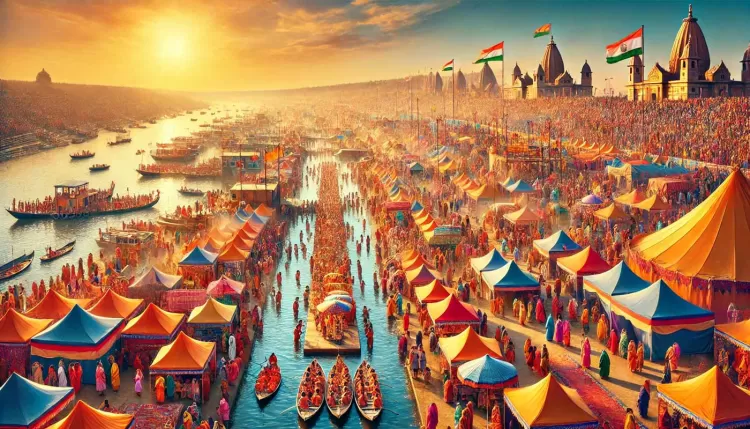Maha Kumbh 2025: Spiritual, Cultural, and Economic Impact in Prayagraj
Discover the grandeur of the Maha Kumbh Festival 2025 in Prayagraj, Uttar Pradesh, attracting over 400 million pilgrims worldwide. Learn about its spiritual significance, cultural heritage, travel surge, international appeal, and economic impact.

The Maha Kumbh Festival 2025: A Detailed Insight
The Maha Kumbh Festival, currently unfolding in the sacred city of Prayagraj, Uttar Pradesh, is not only a spiritual phenomenon but also a transformative event in India’s cultural and tourism landscape. With its profound spiritual significance and unmatched cultural heritage, this once-in-144-years event has become a beacon for millions of pilgrims, drawing visitors from every corner of India and around the globe.
Spiritual Magnet for Millions
Pilgrims from states like Maharashtra, Bihar, West Bengal, Madhya Pradesh, Tamil Nadu, Rajasthan, Karnataka, and Gujarat are journeying to Prayagraj in record numbers to witness and participate in this awe-inspiring event. By the end of February 2025, more than 400 million devotees are expected to take a holy dip at the confluence of the Ganga, Yamuna, and the mythical Saraswati rivers. For countless pilgrims, this is not just a religious journey but a once-in-a-lifetime experience that reaffirms their faith and connects them with ancient traditions.
This massive influx has turned Uttar Pradesh into a bustling hub of economic activity. Hotels, transport networks, and local businesses are experiencing unprecedented growth, reflecting the festival’s enormous economic and cultural impact.
Unity in Diversity
The Maha Kumbh serves as a testament to India’s unity in diversity. From bustling urban centers like Mumbai, Chennai, and Kolkata to serene rural villages, people from varied cultural and social backgrounds converge in Prayagraj, creating a vibrant mosaic of faith and community. This monumental gathering underscores the shared values and traditions that unite India, solidifying Uttar Pradesh’s status as a spiritual and cultural powerhouse.
Skyrocketing Travel Demand and Enhanced Connectivity
The unprecedented scale of the Maha Kumbh Festival has driven a dramatic surge in travel demand. Airfares to Prayagraj and nearby Varanasi have skyrocketed, with one-way tickets from major cities like Delhi, Mumbai, Bengaluru, and Chennai costing upwards of ₹20,000 (231.46 USD). Flights to Varanasi have reached even higher prices, sometimes exceeding ₹40,000 (462.91 USD). To accommodate the growing demand, the Directorate General of Civil Aviation (DGCA) has approved 81 additional flights in January 2025, bringing the total number of flights to Prayagraj to 132. This marks a historic milestone for Prayagraj Airport, which is handling night flights for the first time in its 106-year existence.
Indian Railways has also stepped up, operating over 13,000 trains, including 3,000 special trains, ensuring seamless connectivity for pilgrims nationwide. States like Maharashtra, Bihar, West Bengal, Madhya Pradesh, Tamil Nadu, Rajasthan, Karnataka, and Gujarat are witnessing record bookings, reflecting the festival’s universal appeal.
Domestic Tourism Boom
A survey of over 30,000 airline passengers from 304 districts reveals the diversity of visitors heading to Prayagraj. Among them, 61% are men and 39% women, with 41% coming from tier-1 cities, 29% from tier-2 cities, and 30% from smaller towns and rural areas. The event’s allure spans all demographics, attracting young travelers aged 20-25 as well as older generations.
Buses and trains are witnessing record bookings, with Indian Railways operating special trains to handle the influx. This surge has turned Prayagraj into a melting pot of Indian culture, where chants of prayers, shared meals, and stories among strangers create an unforgettable communal experience.
International Travelers and Global Appeal
The Maha Kumbh’s magnetic pull extends far beyond India’s borders. International travelers from countries like the UK and USA are flocking to Prayagraj, driven by a growing interest in spiritual tourism. Visa agencies have reported a 21% increase in inbound travel to India for spiritual purposes, with a 35% rise in group visa applications. Many international visitors are also exploring other iconic spiritual destinations like Varanasi, Rishikesh, and Haridwar, showcasing India’s global appeal as a hub for spirituality and wellness.
Millennials and women lead this trend, drawn by the transformative experiences the festival offers. Prayagraj’s infrastructure upgrades, including the introduction of night flights and tailored travel packages by airlines and tour operators, ensure seamless experiences for international visitors.
Economic and Local Impact
The Maha Kumbh Festival is not only a spiritual gathering but also a significant economic driver for Uttar Pradesh. As of January 27, 2025, over 110 million pilgrims have already visited Prayagraj, with the number expected to reach 400 million. Hotels, homestays, and other accommodations have reported a 233% increase in bookings, while nearby cities like Varanasi, Lucknow, and Vrindavan are also experiencing a surge in tourism.
Local businesses are thriving, with vendors, transport operators, and tour agencies seeing record sales. The government’s investments in infrastructure, including expanded roads, additional trains and flights, and enhanced airport facilities, have not only supported the festival but also laid the groundwork for sustained regional development.
Spiritual Tourism and India’s Growing Appeal
The Maha Kumbh highlights India’s status as a global spiritual tourism destination. Millennials and international travelers are increasingly seeking meaningful, transformative experiences, extending their trips to explore other spiritual hubs like Varanasi, Rishikesh, and Haridwar. Online platforms report exponential increases in searches for these destinations, reflecting the ripple effect of the Maha Kumbh.
The festival’s global participation reinforces India’s role as a leader in spiritual tourism, uniting people through shared faith and cultural appreciation. Visa applications and group travel packages further underscore this trend, with international visitors eager to immerse themselves in India’s rich traditions.
Exploring Spiritual Sites Around Prayagraj
Visitors attending the Maha Kumbh are also exploring nearby temples and shrines, enhancing their spiritual journey. Some key destinations include:
Maa Lalita Devi Temple
-
Location: Meerapur, part of the 51 Shaktipeethas.
-
Distance: 26 minutes from Prayagraj by train, 20 minutes by car.
Kalyani Devi Temple
-
Highlights: A 1,500-year-old temple with a 32-finger-length idol of Maa Kalyani Devi.
-
Distance: 30 minutes by car, 47 minutes by train from Prayagraj.
Alopshankari Devi Temple
-
Location: Alopibagh, where the fingers of Goddess Sati are said to have fallen.
-
Features: A swing and kund within the temple.
-
Distance: 20 minutes by car, 30-35 minutes by train from Prayagraj.
Ram Mandir
-
Location: A prominent spiritual hub near Prayagraj.
-
Distance: 4.5 hours by car, 5 hours by train.
The Maha Kumbh Festival is not just an event—it’s a movement that unites faith, culture, and community, leaving a lasting impact on India’s spiritual and cultural landscape.
















